Bank Nizwa: Employee Retention, Training, and Performance Appraisal
VerifiedAdded on 2023/04/20
|43
|5900
|188
Report
AI Summary
This report presents a quantitative descriptive research study examining the influence of training and performance appraisal on employee retention at Bank Nizwa. The study utilized a questionnaire administered to a sample of 40 employees to gather data on demographic profiles, training selection criteria, and employee perceptions of training quality, coaching opportunities, and performance appraisal effectiveness. Findings indicate a positive relationship between training programs, coaching practices, and performance appraisals, and employee motivation and retention. The research also highlights the importance of various factors influencing employee retention, including the quality of training programs, relevant training sessions, and the effectiveness of performance appraisal systems. The study concludes with recommendations for improving employee retention strategies at Bank Nizwa, emphasizing the need for continuous training and development programs and effective performance management systems.
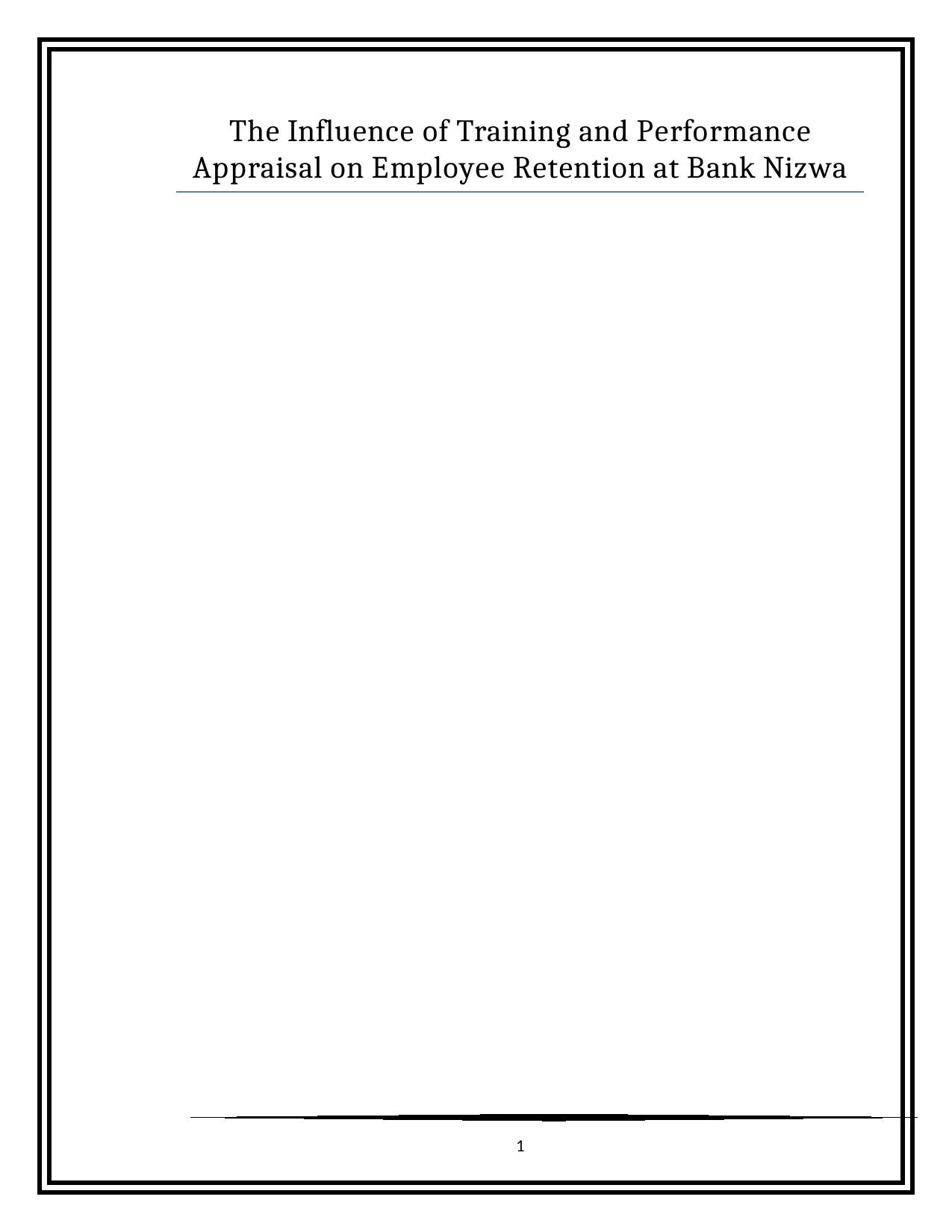
The Influence of Training and Performance
Appraisal on Employee Retention at Bank Nizwa
1
Appraisal on Employee Retention at Bank Nizwa
1
Paraphrase This Document
Need a fresh take? Get an instant paraphrase of this document with our AI Paraphraser
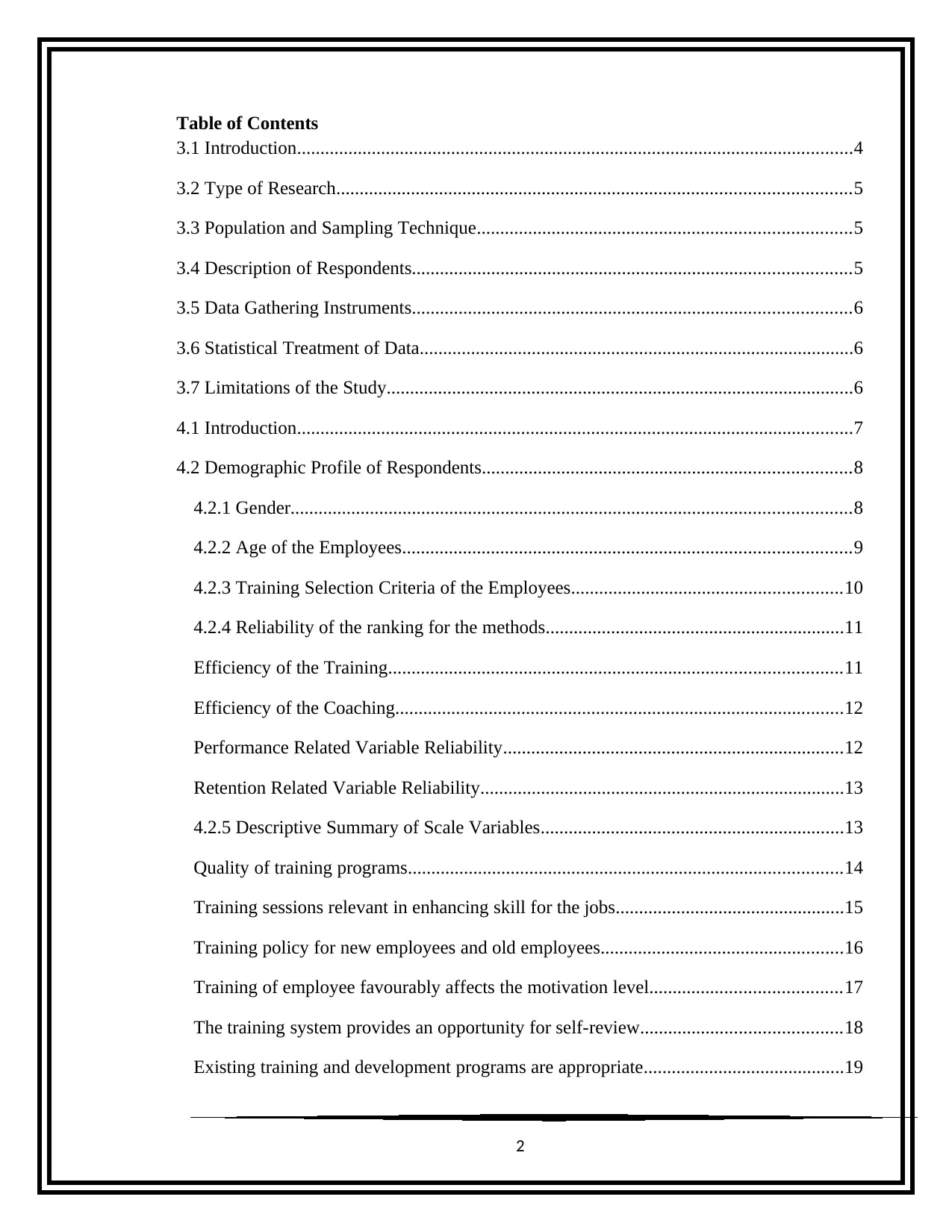
Table of Contents
3.1 Introduction.......................................................................................................................4
3.2 Type of Research..............................................................................................................5
3.3 Population and Sampling Technique................................................................................5
3.4 Description of Respondents..............................................................................................5
3.5 Data Gathering Instruments..............................................................................................6
3.6 Statistical Treatment of Data.............................................................................................6
3.7 Limitations of the Study....................................................................................................6
4.1 Introduction.......................................................................................................................7
4.2 Demographic Profile of Respondents...............................................................................8
4.2.1 Gender........................................................................................................................8
4.2.2 Age of the Employees................................................................................................9
4.2.3 Training Selection Criteria of the Employees..........................................................10
4.2.4 Reliability of the ranking for the methods................................................................11
Efficiency of the Training.................................................................................................11
Efficiency of the Coaching................................................................................................12
Performance Related Variable Reliability.........................................................................12
Retention Related Variable Reliability..............................................................................13
4.2.5 Descriptive Summary of Scale Variables.................................................................13
Quality of training programs.............................................................................................14
Training sessions relevant in enhancing skill for the jobs.................................................15
Training policy for new employees and old employees....................................................16
Training of employee favourably affects the motivation level.........................................17
The training system provides an opportunity for self-review...........................................18
Existing training and development programs are appropriate...........................................19
2
3.1 Introduction.......................................................................................................................4
3.2 Type of Research..............................................................................................................5
3.3 Population and Sampling Technique................................................................................5
3.4 Description of Respondents..............................................................................................5
3.5 Data Gathering Instruments..............................................................................................6
3.6 Statistical Treatment of Data.............................................................................................6
3.7 Limitations of the Study....................................................................................................6
4.1 Introduction.......................................................................................................................7
4.2 Demographic Profile of Respondents...............................................................................8
4.2.1 Gender........................................................................................................................8
4.2.2 Age of the Employees................................................................................................9
4.2.3 Training Selection Criteria of the Employees..........................................................10
4.2.4 Reliability of the ranking for the methods................................................................11
Efficiency of the Training.................................................................................................11
Efficiency of the Coaching................................................................................................12
Performance Related Variable Reliability.........................................................................12
Retention Related Variable Reliability..............................................................................13
4.2.5 Descriptive Summary of Scale Variables.................................................................13
Quality of training programs.............................................................................................14
Training sessions relevant in enhancing skill for the jobs.................................................15
Training policy for new employees and old employees....................................................16
Training of employee favourably affects the motivation level.........................................17
The training system provides an opportunity for self-review...........................................18
Existing training and development programs are appropriate...........................................19
2
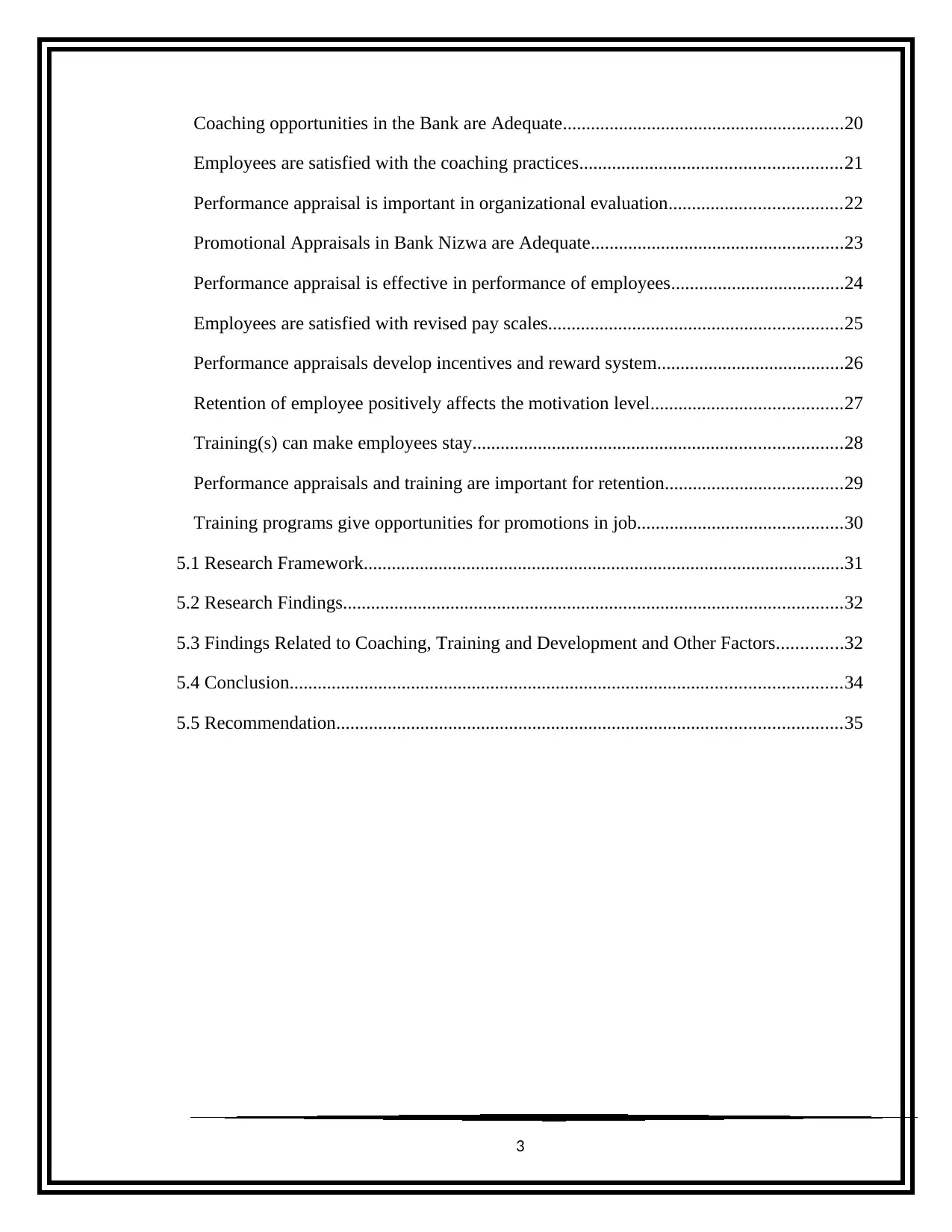
Coaching opportunities in the Bank are Adequate............................................................20
Employees are satisfied with the coaching practices........................................................21
Performance appraisal is important in organizational evaluation.....................................22
Promotional Appraisals in Bank Nizwa are Adequate......................................................23
Performance appraisal is effective in performance of employees.....................................24
Employees are satisfied with revised pay scales...............................................................25
Performance appraisals develop incentives and reward system........................................26
Retention of employee positively affects the motivation level.........................................27
Training(s) can make employees stay...............................................................................28
Performance appraisals and training are important for retention......................................29
Training programs give opportunities for promotions in job............................................30
5.1 Research Framework.......................................................................................................31
5.2 Research Findings...........................................................................................................32
5.3 Findings Related to Coaching, Training and Development and Other Factors..............32
5.4 Conclusion......................................................................................................................34
5.5 Recommendation............................................................................................................35
3
Employees are satisfied with the coaching practices........................................................21
Performance appraisal is important in organizational evaluation.....................................22
Promotional Appraisals in Bank Nizwa are Adequate......................................................23
Performance appraisal is effective in performance of employees.....................................24
Employees are satisfied with revised pay scales...............................................................25
Performance appraisals develop incentives and reward system........................................26
Retention of employee positively affects the motivation level.........................................27
Training(s) can make employees stay...............................................................................28
Performance appraisals and training are important for retention......................................29
Training programs give opportunities for promotions in job............................................30
5.1 Research Framework.......................................................................................................31
5.2 Research Findings...........................................................................................................32
5.3 Findings Related to Coaching, Training and Development and Other Factors..............32
5.4 Conclusion......................................................................................................................34
5.5 Recommendation............................................................................................................35
3
⊘ This is a preview!⊘
Do you want full access?
Subscribe today to unlock all pages.

Trusted by 1+ million students worldwide
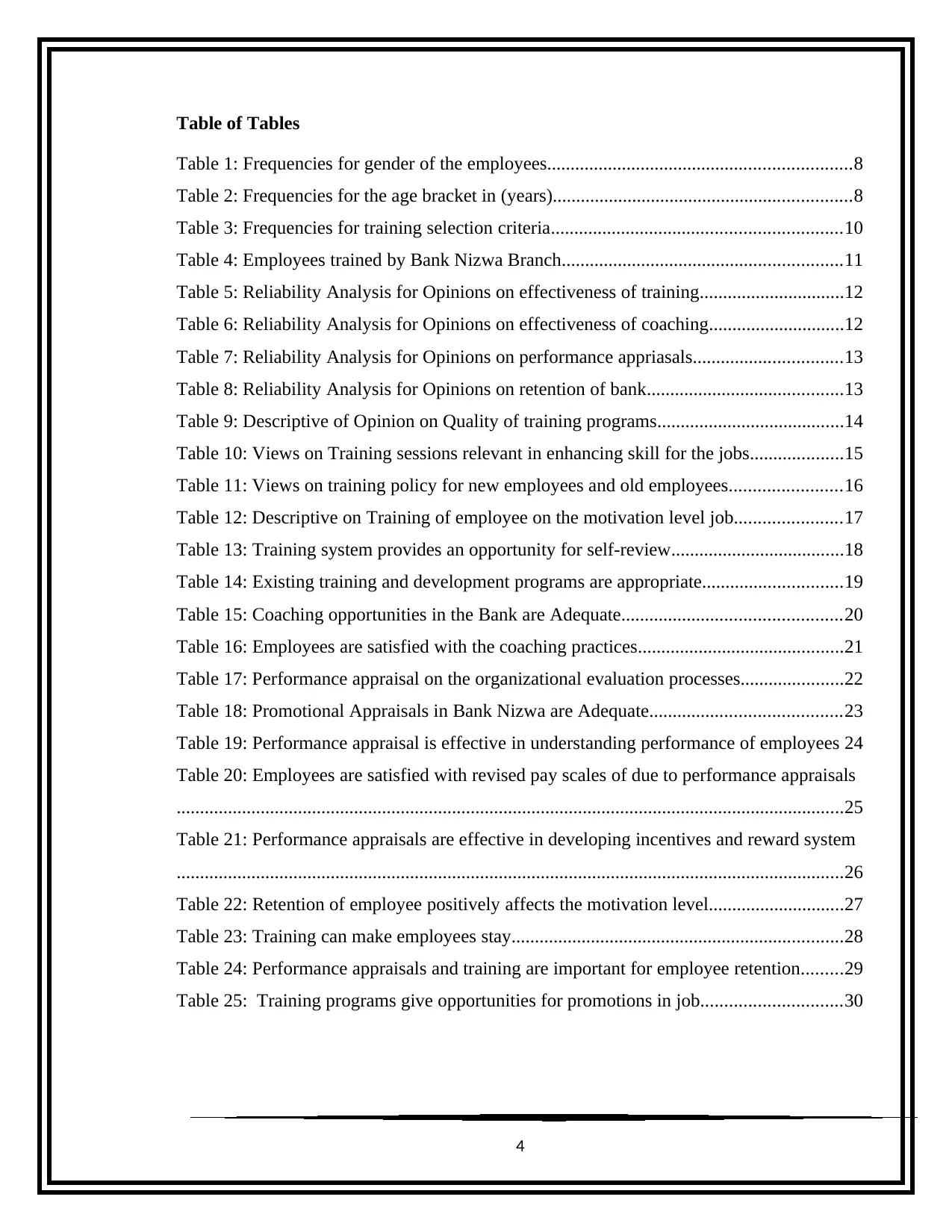
Table of Tables
Table 1: Frequencies for gender of the employees.................................................................8
Table 2: Frequencies for the age bracket in (years)................................................................8
Table 3: Frequencies for training selection criteria..............................................................10
Table 4: Employees trained by Bank Nizwa Branch............................................................11
Table 5: Reliability Analysis for Opinions on effectiveness of training...............................12
Table 6: Reliability Analysis for Opinions on effectiveness of coaching.............................12
Table 7: Reliability Analysis for Opinions on performance appriasals................................13
Table 8: Reliability Analysis for Opinions on retention of bank..........................................13
Table 9: Descriptive of Opinion on Quality of training programs........................................14
Table 10: Views on Training sessions relevant in enhancing skill for the jobs....................15
Table 11: Views on training policy for new employees and old employees........................16
Table 12: Descriptive on Training of employee on the motivation level job.......................17
Table 13: Training system provides an opportunity for self-review.....................................18
Table 14: Existing training and development programs are appropriate..............................19
Table 15: Coaching opportunities in the Bank are Adequate...............................................20
Table 16: Employees are satisfied with the coaching practices............................................21
Table 17: Performance appraisal on the organizational evaluation processes......................22
Table 18: Promotional Appraisals in Bank Nizwa are Adequate.........................................23
Table 19: Performance appraisal is effective in understanding performance of employees 24
Table 20: Employees are satisfied with revised pay scales of due to performance appraisals
...............................................................................................................................................25
Table 21: Performance appraisals are effective in developing incentives and reward system
...............................................................................................................................................26
Table 22: Retention of employee positively affects the motivation level.............................27
Table 23: Training can make employees stay.......................................................................28
Table 24: Performance appraisals and training are important for employee retention.........29
Table 25: Training programs give opportunities for promotions in job..............................30
4
Table 1: Frequencies for gender of the employees.................................................................8
Table 2: Frequencies for the age bracket in (years)................................................................8
Table 3: Frequencies for training selection criteria..............................................................10
Table 4: Employees trained by Bank Nizwa Branch............................................................11
Table 5: Reliability Analysis for Opinions on effectiveness of training...............................12
Table 6: Reliability Analysis for Opinions on effectiveness of coaching.............................12
Table 7: Reliability Analysis for Opinions on performance appriasals................................13
Table 8: Reliability Analysis for Opinions on retention of bank..........................................13
Table 9: Descriptive of Opinion on Quality of training programs........................................14
Table 10: Views on Training sessions relevant in enhancing skill for the jobs....................15
Table 11: Views on training policy for new employees and old employees........................16
Table 12: Descriptive on Training of employee on the motivation level job.......................17
Table 13: Training system provides an opportunity for self-review.....................................18
Table 14: Existing training and development programs are appropriate..............................19
Table 15: Coaching opportunities in the Bank are Adequate...............................................20
Table 16: Employees are satisfied with the coaching practices............................................21
Table 17: Performance appraisal on the organizational evaluation processes......................22
Table 18: Promotional Appraisals in Bank Nizwa are Adequate.........................................23
Table 19: Performance appraisal is effective in understanding performance of employees 24
Table 20: Employees are satisfied with revised pay scales of due to performance appraisals
...............................................................................................................................................25
Table 21: Performance appraisals are effective in developing incentives and reward system
...............................................................................................................................................26
Table 22: Retention of employee positively affects the motivation level.............................27
Table 23: Training can make employees stay.......................................................................28
Table 24: Performance appraisals and training are important for employee retention.........29
Table 25: Training programs give opportunities for promotions in job..............................30
4
Paraphrase This Document
Need a fresh take? Get an instant paraphrase of this document with our AI Paraphraser
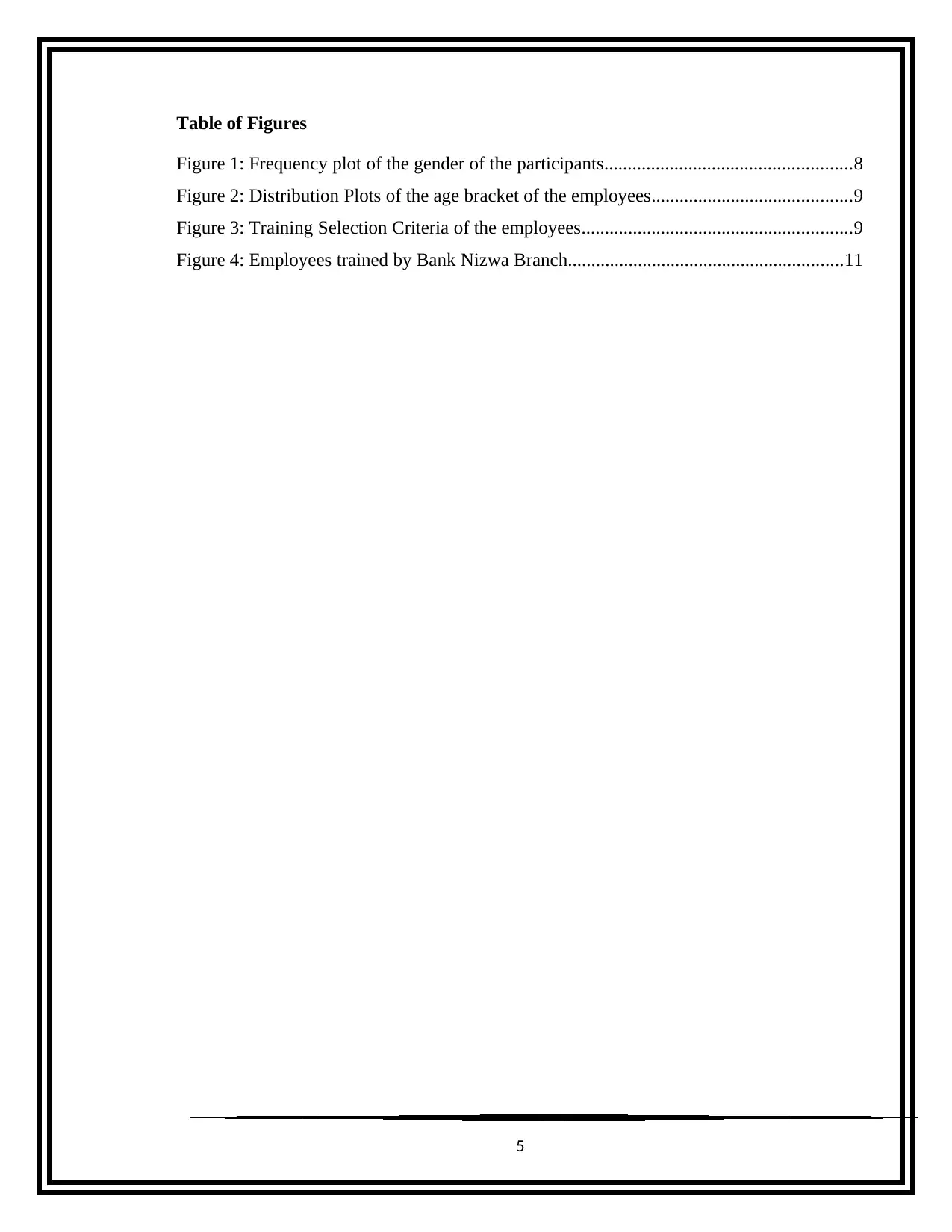
Table of Figures
Figure 1: Frequency plot of the gender of the participants.....................................................8
Figure 2: Distribution Plots of the age bracket of the employees...........................................9
Figure 3: Training Selection Criteria of the employees..........................................................9
Figure 4: Employees trained by Bank Nizwa Branch...........................................................11
5
Figure 1: Frequency plot of the gender of the participants.....................................................8
Figure 2: Distribution Plots of the age bracket of the employees...........................................9
Figure 3: Training Selection Criteria of the employees..........................................................9
Figure 4: Employees trained by Bank Nizwa Branch...........................................................11
5
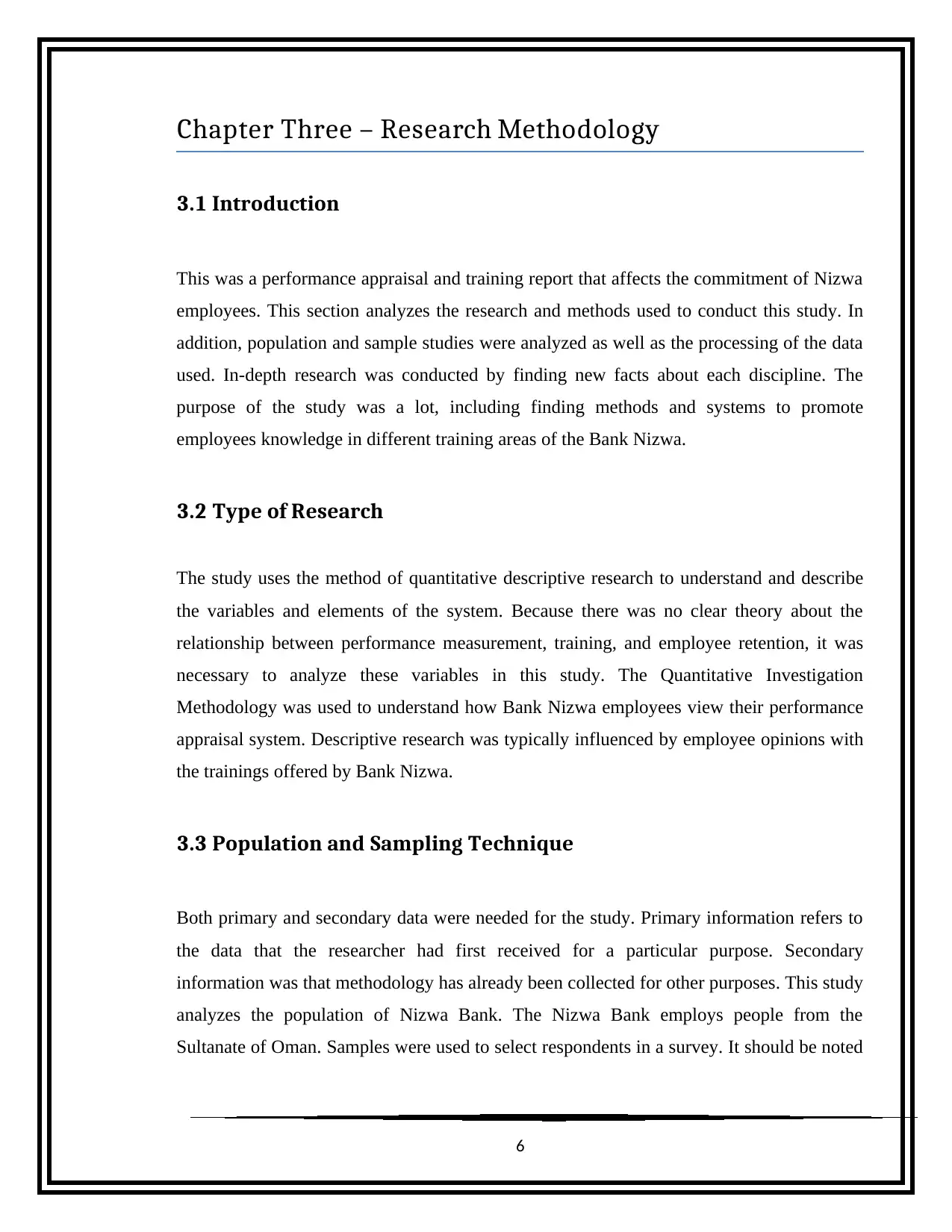
Chapter Three – Research Methodology
3.1 Introduction
This was a performance appraisal and training report that affects the commitment of Nizwa
employees. This section analyzes the research and methods used to conduct this study. In
addition, population and sample studies were analyzed as well as the processing of the data
used. In-depth research was conducted by finding new facts about each discipline. The
purpose of the study was a lot, including finding methods and systems to promote
employees knowledge in different training areas of the Bank Nizwa.
3.2 Type of Research
The study uses the method of quantitative descriptive research to understand and describe
the variables and elements of the system. Because there was no clear theory about the
relationship between performance measurement, training, and employee retention, it was
necessary to analyze these variables in this study. The Quantitative Investigation
Methodology was used to understand how Bank Nizwa employees view their performance
appraisal system. Descriptive research was typically influenced by employee opinions with
the trainings offered by Bank Nizwa.
3.3 Population and Sampling Technique
Both primary and secondary data were needed for the study. Primary information refers to
the data that the researcher had first received for a particular purpose. Secondary
information was that methodology has already been collected for other purposes. This study
analyzes the population of Nizwa Bank. The Nizwa Bank employs people from the
Sultanate of Oman. Samples were used to select respondents in a survey. It should be noted
6
3.1 Introduction
This was a performance appraisal and training report that affects the commitment of Nizwa
employees. This section analyzes the research and methods used to conduct this study. In
addition, population and sample studies were analyzed as well as the processing of the data
used. In-depth research was conducted by finding new facts about each discipline. The
purpose of the study was a lot, including finding methods and systems to promote
employees knowledge in different training areas of the Bank Nizwa.
3.2 Type of Research
The study uses the method of quantitative descriptive research to understand and describe
the variables and elements of the system. Because there was no clear theory about the
relationship between performance measurement, training, and employee retention, it was
necessary to analyze these variables in this study. The Quantitative Investigation
Methodology was used to understand how Bank Nizwa employees view their performance
appraisal system. Descriptive research was typically influenced by employee opinions with
the trainings offered by Bank Nizwa.
3.3 Population and Sampling Technique
Both primary and secondary data were needed for the study. Primary information refers to
the data that the researcher had first received for a particular purpose. Secondary
information was that methodology has already been collected for other purposes. This study
analyzes the population of Nizwa Bank. The Nizwa Bank employs people from the
Sultanate of Oman. Samples were used to select respondents in a survey. It should be noted
6
⊘ This is a preview!⊘
Do you want full access?
Subscribe today to unlock all pages.

Trusted by 1+ million students worldwide
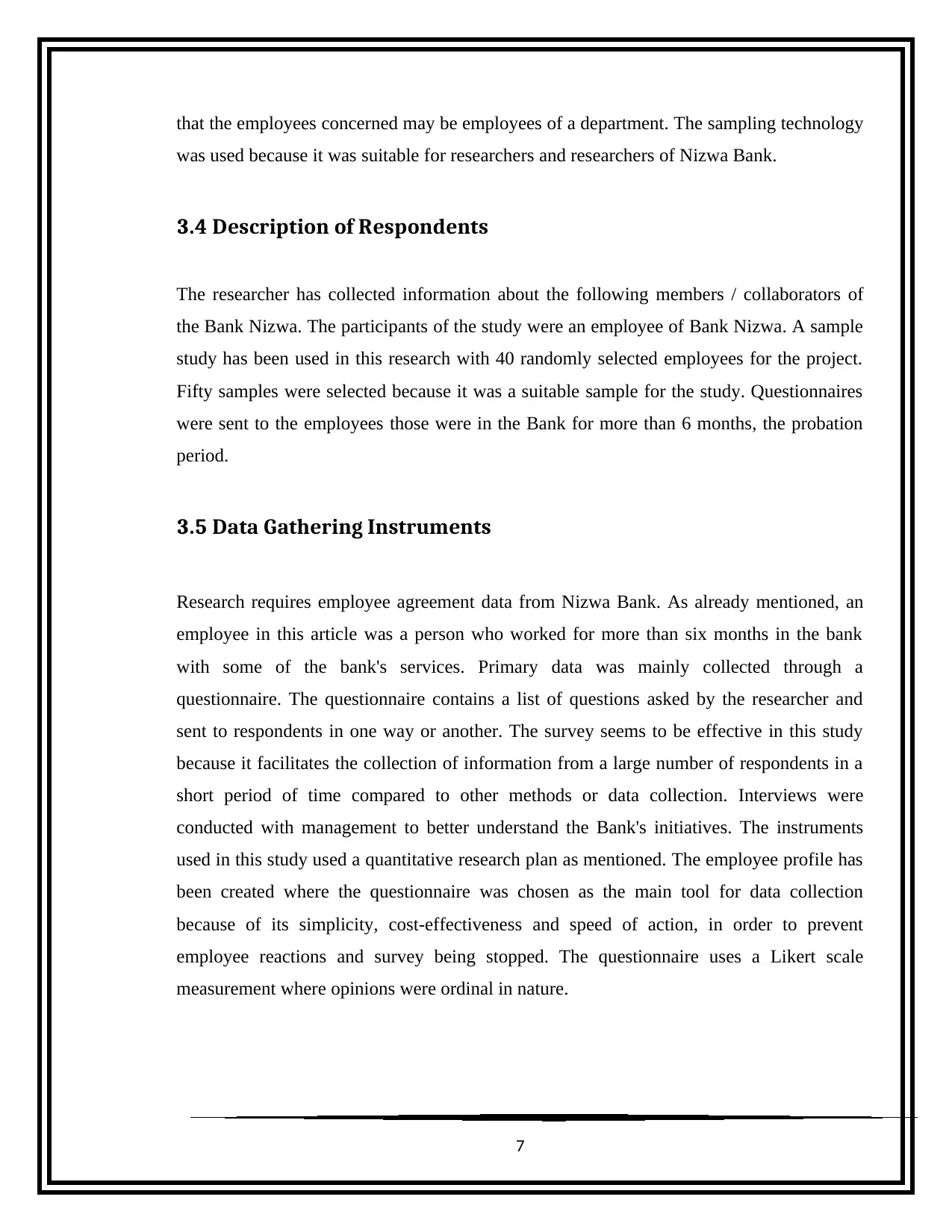
that the employees concerned may be employees of a department. The sampling technology
was used because it was suitable for researchers and researchers of Nizwa Bank.
3.4 Description of Respondents
The researcher has collected information about the following members / collaborators of
the Bank Nizwa. The participants of the study were an employee of Bank Nizwa. A sample
study has been used in this research with 40 randomly selected employees for the project.
Fifty samples were selected because it was a suitable sample for the study. Questionnaires
were sent to the employees those were in the Bank for more than 6 months, the probation
period.
3.5 Data Gathering Instruments
Research requires employee agreement data from Nizwa Bank. As already mentioned, an
employee in this article was a person who worked for more than six months in the bank
with some of the bank's services. Primary data was mainly collected through a
questionnaire. The questionnaire contains a list of questions asked by the researcher and
sent to respondents in one way or another. The survey seems to be effective in this study
because it facilitates the collection of information from a large number of respondents in a
short period of time compared to other methods or data collection. Interviews were
conducted with management to better understand the Bank's initiatives. The instruments
used in this study used a quantitative research plan as mentioned. The employee profile has
been created where the questionnaire was chosen as the main tool for data collection
because of its simplicity, cost-effectiveness and speed of action, in order to prevent
employee reactions and survey being stopped. The questionnaire uses a Likert scale
measurement where opinions were ordinal in nature.
7
was used because it was suitable for researchers and researchers of Nizwa Bank.
3.4 Description of Respondents
The researcher has collected information about the following members / collaborators of
the Bank Nizwa. The participants of the study were an employee of Bank Nizwa. A sample
study has been used in this research with 40 randomly selected employees for the project.
Fifty samples were selected because it was a suitable sample for the study. Questionnaires
were sent to the employees those were in the Bank for more than 6 months, the probation
period.
3.5 Data Gathering Instruments
Research requires employee agreement data from Nizwa Bank. As already mentioned, an
employee in this article was a person who worked for more than six months in the bank
with some of the bank's services. Primary data was mainly collected through a
questionnaire. The questionnaire contains a list of questions asked by the researcher and
sent to respondents in one way or another. The survey seems to be effective in this study
because it facilitates the collection of information from a large number of respondents in a
short period of time compared to other methods or data collection. Interviews were
conducted with management to better understand the Bank's initiatives. The instruments
used in this study used a quantitative research plan as mentioned. The employee profile has
been created where the questionnaire was chosen as the main tool for data collection
because of its simplicity, cost-effectiveness and speed of action, in order to prevent
employee reactions and survey being stopped. The questionnaire uses a Likert scale
measurement where opinions were ordinal in nature.
7
Paraphrase This Document
Need a fresh take? Get an instant paraphrase of this document with our AI Paraphraser
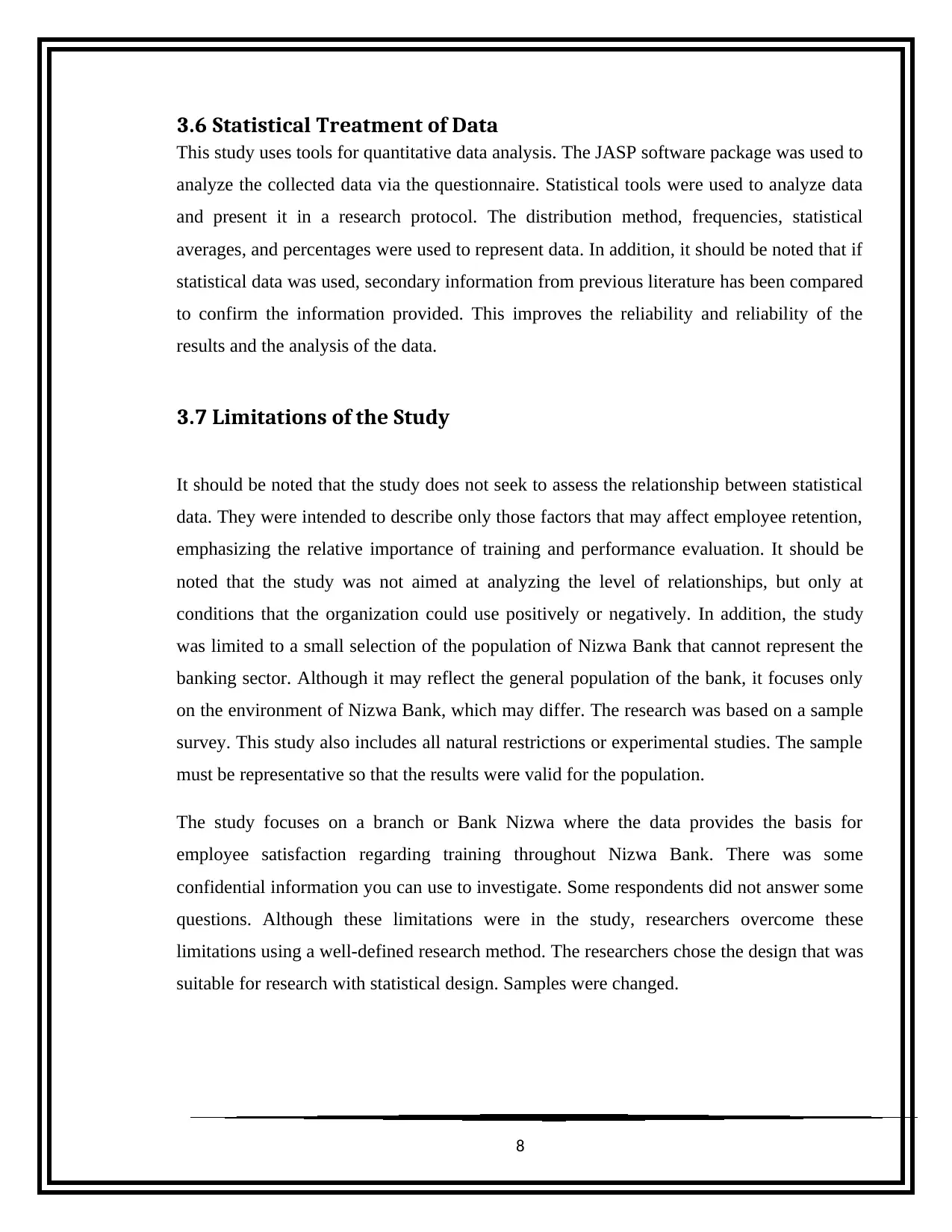
3.6 Statistical Treatment of Data
This study uses tools for quantitative data analysis. The JASP software package was used to
analyze the collected data via the questionnaire. Statistical tools were used to analyze data
and present it in a research protocol. The distribution method, frequencies, statistical
averages, and percentages were used to represent data. In addition, it should be noted that if
statistical data was used, secondary information from previous literature has been compared
to confirm the information provided. This improves the reliability and reliability of the
results and the analysis of the data.
3.7 Limitations of the Study
It should be noted that the study does not seek to assess the relationship between statistical
data. They were intended to describe only those factors that may affect employee retention,
emphasizing the relative importance of training and performance evaluation. It should be
noted that the study was not aimed at analyzing the level of relationships, but only at
conditions that the organization could use positively or negatively. In addition, the study
was limited to a small selection of the population of Nizwa Bank that cannot represent the
banking sector. Although it may reflect the general population of the bank, it focuses only
on the environment of Nizwa Bank, which may differ. The research was based on a sample
survey. This study also includes all natural restrictions or experimental studies. The sample
must be representative so that the results were valid for the population.
The study focuses on a branch or Bank Nizwa where the data provides the basis for
employee satisfaction regarding training throughout Nizwa Bank. There was some
confidential information you can use to investigate. Some respondents did not answer some
questions. Although these limitations were in the study, researchers overcome these
limitations using a well-defined research method. The researchers chose the design that was
suitable for research with statistical design. Samples were changed.
8
This study uses tools for quantitative data analysis. The JASP software package was used to
analyze the collected data via the questionnaire. Statistical tools were used to analyze data
and present it in a research protocol. The distribution method, frequencies, statistical
averages, and percentages were used to represent data. In addition, it should be noted that if
statistical data was used, secondary information from previous literature has been compared
to confirm the information provided. This improves the reliability and reliability of the
results and the analysis of the data.
3.7 Limitations of the Study
It should be noted that the study does not seek to assess the relationship between statistical
data. They were intended to describe only those factors that may affect employee retention,
emphasizing the relative importance of training and performance evaluation. It should be
noted that the study was not aimed at analyzing the level of relationships, but only at
conditions that the organization could use positively or negatively. In addition, the study
was limited to a small selection of the population of Nizwa Bank that cannot represent the
banking sector. Although it may reflect the general population of the bank, it focuses only
on the environment of Nizwa Bank, which may differ. The research was based on a sample
survey. This study also includes all natural restrictions or experimental studies. The sample
must be representative so that the results were valid for the population.
The study focuses on a branch or Bank Nizwa where the data provides the basis for
employee satisfaction regarding training throughout Nizwa Bank. There was some
confidential information you can use to investigate. Some respondents did not answer some
questions. Although these limitations were in the study, researchers overcome these
limitations using a well-defined research method. The researchers chose the design that was
suitable for research with statistical design. Samples were changed.
8
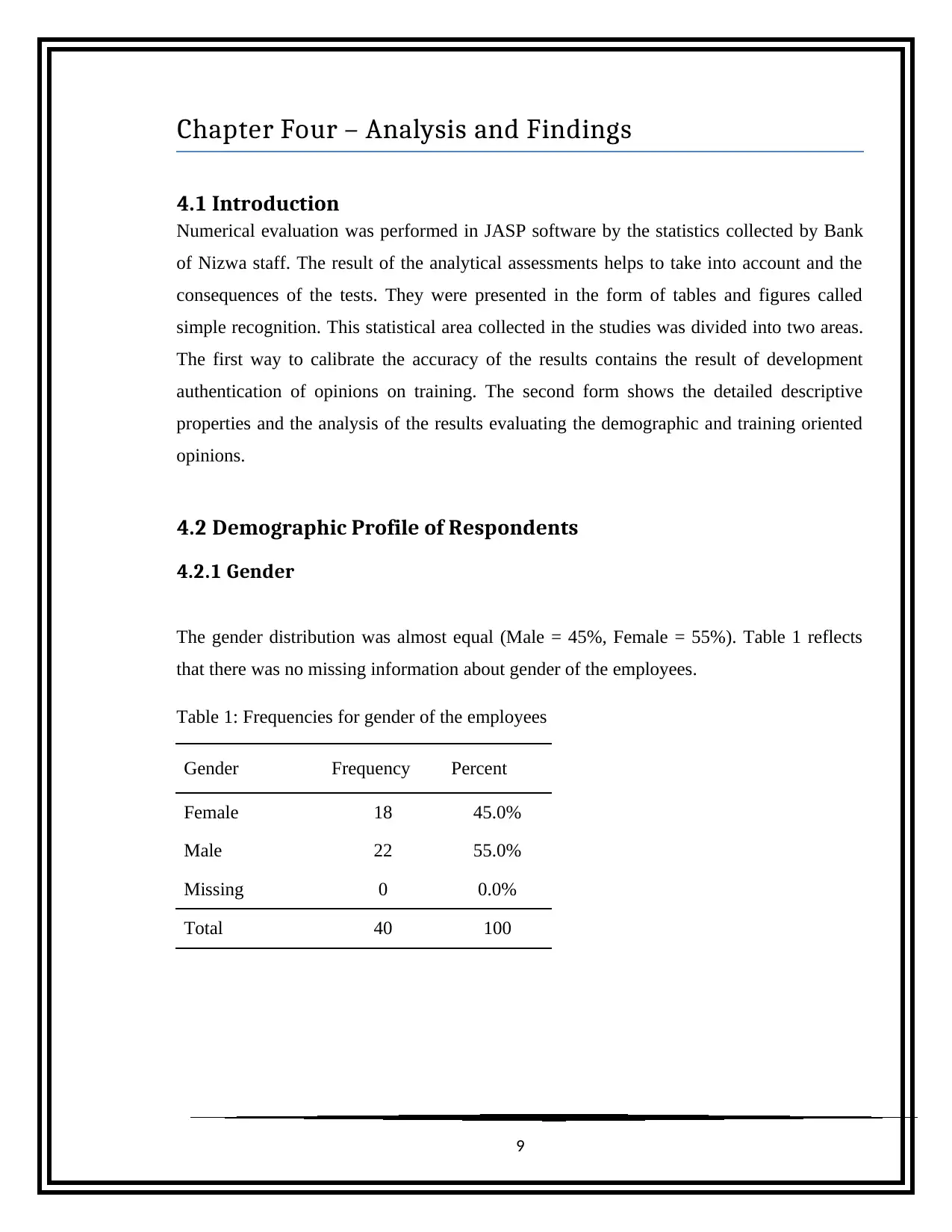
Chapter Four – Analysis and Findings
4.1 Introduction
Numerical evaluation was performed in JASP software by the statistics collected by Bank
of Nizwa staff. The result of the analytical assessments helps to take into account and the
consequences of the tests. They were presented in the form of tables and figures called
simple recognition. This statistical area collected in the studies was divided into two areas.
The first way to calibrate the accuracy of the results contains the result of development
authentication of opinions on training. The second form shows the detailed descriptive
properties and the analysis of the results evaluating the demographic and training oriented
opinions.
4.2 Demographic Profile of Respondents
4.2.1 Gender
The gender distribution was almost equal (Male = 45%, Female = 55%). Table 1 reflects
that there was no missing information about gender of the employees.
Table 1: Frequencies for gender of the employees
Gender Frequency Percent
Female 18 45.0%
Male 22 55.0%
Missing 0 0.0%
Total 40 100
9
4.1 Introduction
Numerical evaluation was performed in JASP software by the statistics collected by Bank
of Nizwa staff. The result of the analytical assessments helps to take into account and the
consequences of the tests. They were presented in the form of tables and figures called
simple recognition. This statistical area collected in the studies was divided into two areas.
The first way to calibrate the accuracy of the results contains the result of development
authentication of opinions on training. The second form shows the detailed descriptive
properties and the analysis of the results evaluating the demographic and training oriented
opinions.
4.2 Demographic Profile of Respondents
4.2.1 Gender
The gender distribution was almost equal (Male = 45%, Female = 55%). Table 1 reflects
that there was no missing information about gender of the employees.
Table 1: Frequencies for gender of the employees
Gender Frequency Percent
Female 18 45.0%
Male 22 55.0%
Missing 0 0.0%
Total 40 100
9
⊘ This is a preview!⊘
Do you want full access?
Subscribe today to unlock all pages.

Trusted by 1+ million students worldwide
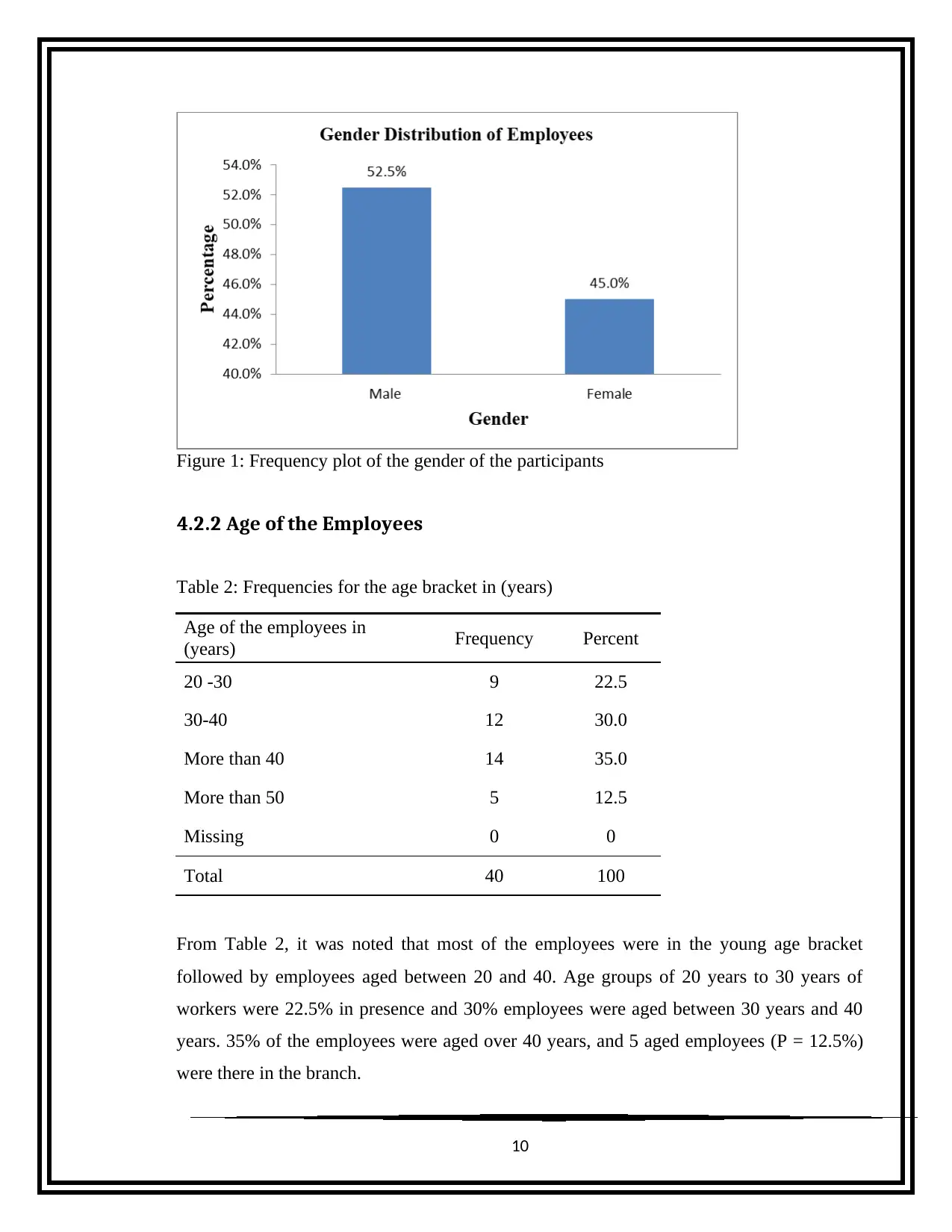
Figure 1: Frequency plot of the gender of the participants
4.2.2 Age of the Employees
Table 2: Frequencies for the age bracket in (years)
Age of the employees in
(years) Frequency Percent
20 -30 9 22.5
30-40 12 30.0
More than 40 14 35.0
More than 50 5 12.5
Missing 0 0
Total 40 100
From Table 2, it was noted that most of the employees were in the young age bracket
followed by employees aged between 20 and 40. Age groups of 20 years to 30 years of
workers were 22.5% in presence and 30% employees were aged between 30 years and 40
years. 35% of the employees were aged over 40 years, and 5 aged employees (P = 12.5%)
were there in the branch.
10
4.2.2 Age of the Employees
Table 2: Frequencies for the age bracket in (years)
Age of the employees in
(years) Frequency Percent
20 -30 9 22.5
30-40 12 30.0
More than 40 14 35.0
More than 50 5 12.5
Missing 0 0
Total 40 100
From Table 2, it was noted that most of the employees were in the young age bracket
followed by employees aged between 20 and 40. Age groups of 20 years to 30 years of
workers were 22.5% in presence and 30% employees were aged between 30 years and 40
years. 35% of the employees were aged over 40 years, and 5 aged employees (P = 12.5%)
were there in the branch.
10
Paraphrase This Document
Need a fresh take? Get an instant paraphrase of this document with our AI Paraphraser
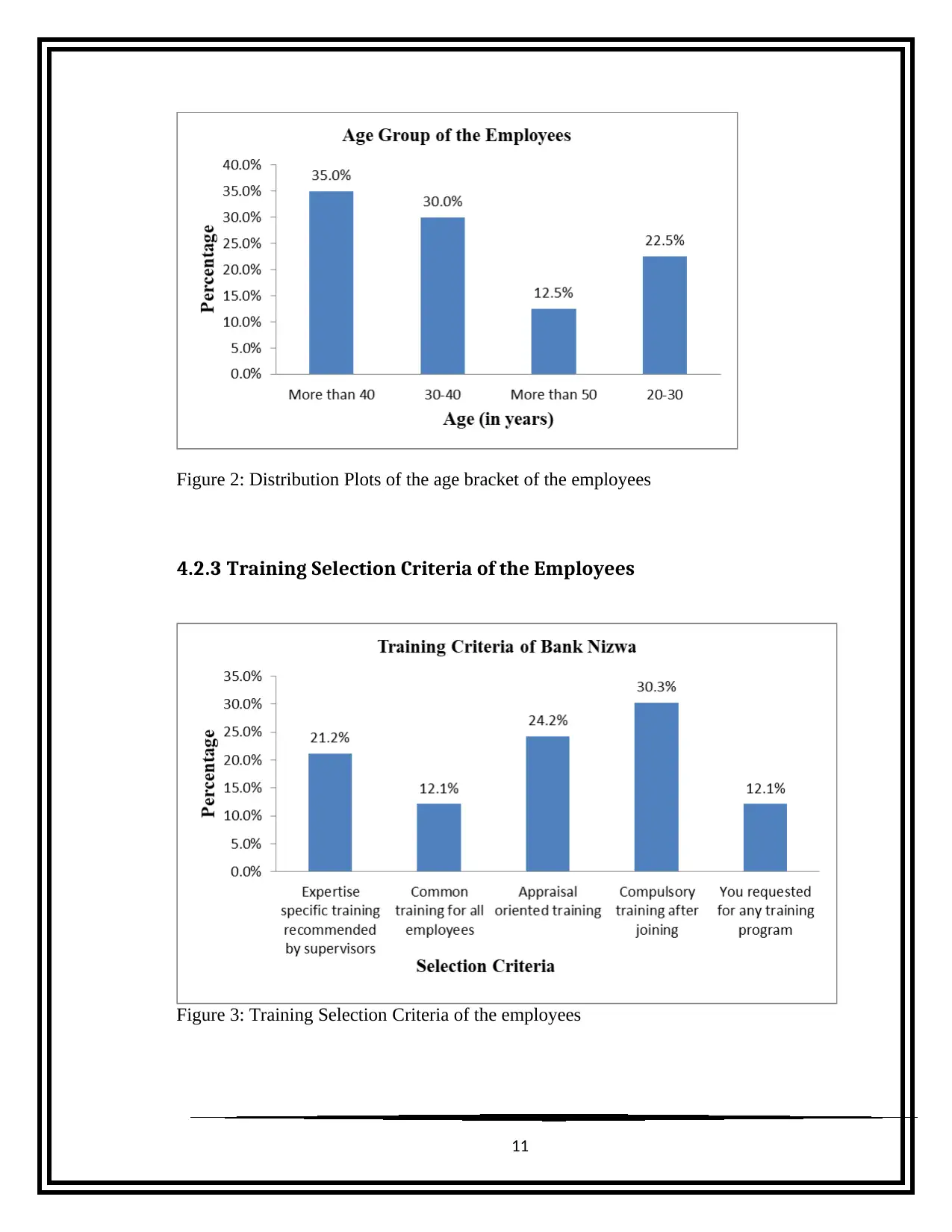
Figure 2: Distribution Plots of the age bracket of the employees
4.2.3 Training Selection Criteria of the Employees
Figure 3: Training Selection Criteria of the employees
11
4.2.3 Training Selection Criteria of the Employees
Figure 3: Training Selection Criteria of the employees
11
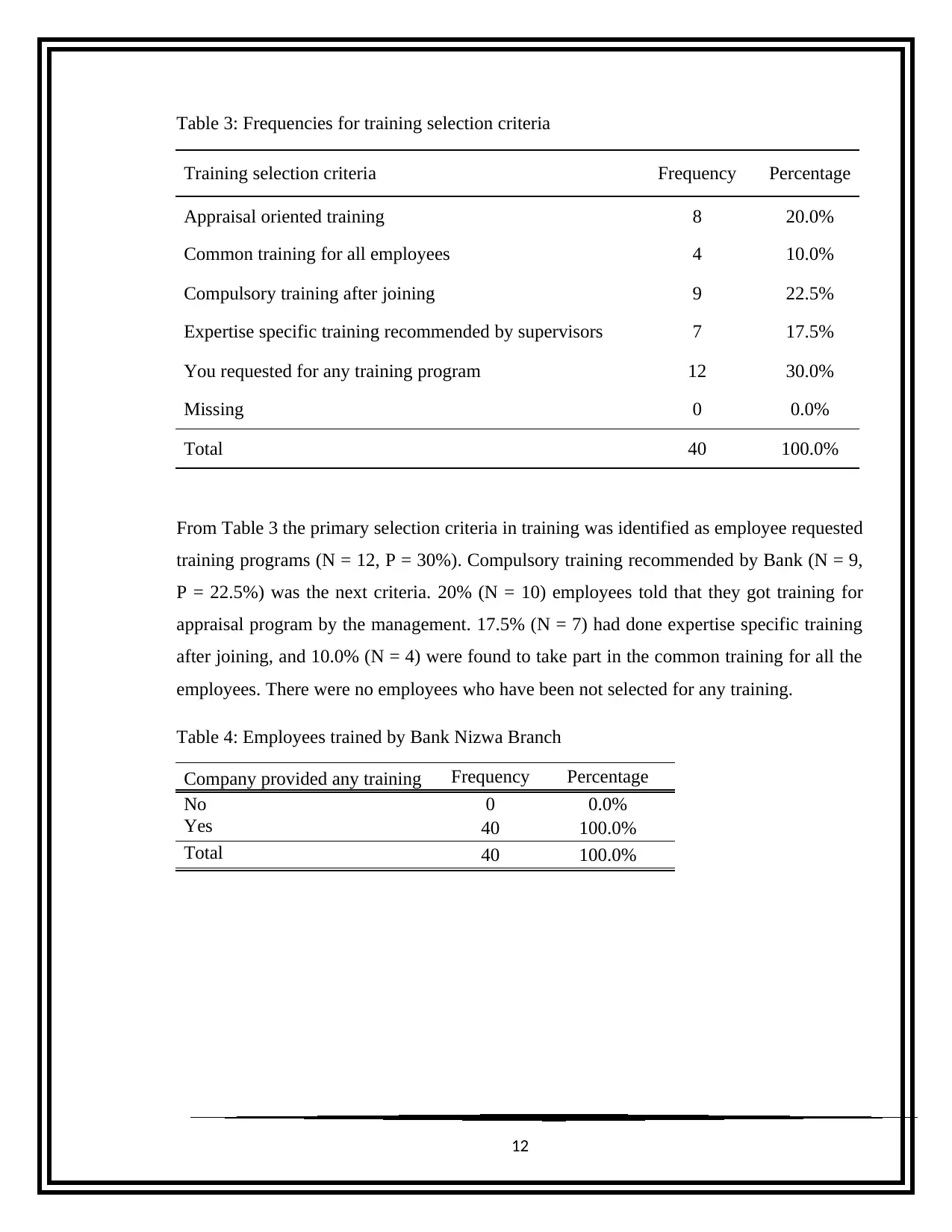
Table 3: Frequencies for training selection criteria
Training selection criteria Frequency Percentage
Appraisal oriented training 8 20.0%
Common training for all employees 4 10.0%
Compulsory training after joining 9 22.5%
Expertise specific training recommended by supervisors 7 17.5%
You requested for any training program 12 30.0%
Missing 0 0.0%
Total 40 100.0%
From Table 3 the primary selection criteria in training was identified as employee requested
training programs (N = 12, P = 30%). Compulsory training recommended by Bank (N = 9,
P = 22.5%) was the next criteria. 20% (N = 10) employees told that they got training for
appraisal program by the management. 17.5% (N = 7) had done expertise specific training
after joining, and 10.0% (N = 4) were found to take part in the common training for all the
employees. There were no employees who have been not selected for any training.
Table 4: Employees trained by Bank Nizwa Branch
Company provided any training Frequency Percentage
No 0 0.0%
Yes 40 100.0%
Total 40 100.0%
12
Training selection criteria Frequency Percentage
Appraisal oriented training 8 20.0%
Common training for all employees 4 10.0%
Compulsory training after joining 9 22.5%
Expertise specific training recommended by supervisors 7 17.5%
You requested for any training program 12 30.0%
Missing 0 0.0%
Total 40 100.0%
From Table 3 the primary selection criteria in training was identified as employee requested
training programs (N = 12, P = 30%). Compulsory training recommended by Bank (N = 9,
P = 22.5%) was the next criteria. 20% (N = 10) employees told that they got training for
appraisal program by the management. 17.5% (N = 7) had done expertise specific training
after joining, and 10.0% (N = 4) were found to take part in the common training for all the
employees. There were no employees who have been not selected for any training.
Table 4: Employees trained by Bank Nizwa Branch
Company provided any training Frequency Percentage
No 0 0.0%
Yes 40 100.0%
Total 40 100.0%
12
⊘ This is a preview!⊘
Do you want full access?
Subscribe today to unlock all pages.

Trusted by 1+ million students worldwide
1 out of 43
Related Documents
Your All-in-One AI-Powered Toolkit for Academic Success.
+13062052269
info@desklib.com
Available 24*7 on WhatsApp / Email
![[object Object]](/_next/static/media/star-bottom.7253800d.svg)
Unlock your academic potential
Copyright © 2020–2025 A2Z Services. All Rights Reserved. Developed and managed by ZUCOL.





